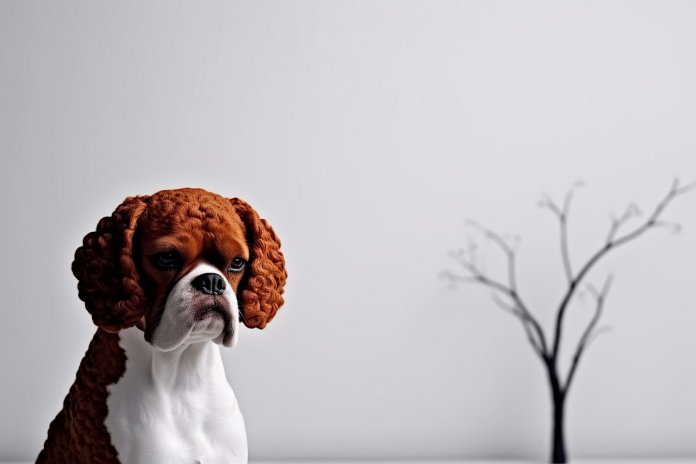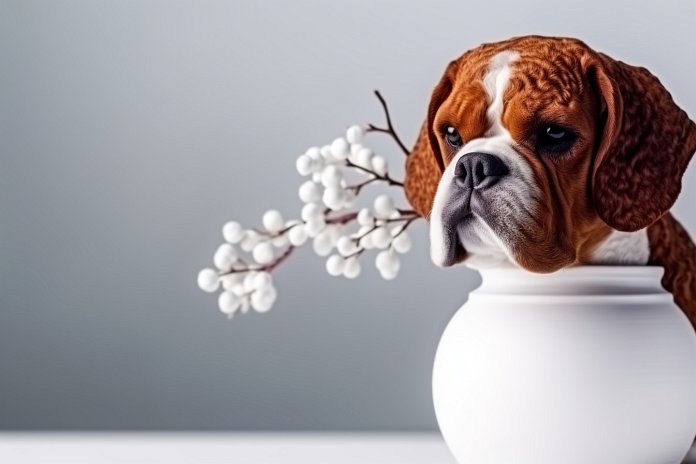
The Boxerdoodle is a popular hybrid breed known for being friendly, great with children, and easy to train. One interesting aspect of this breed is that its size can vary depending on which type of Poodle parent it has. There are three varieties of Poodles: toy, miniature, and standard. As a result, Boxerdoodles can range in size from small to large. They can weigh anywhere between 12 to 70 pounds and stand 10 to 25 inches tall.
Boxerdoodles have a thick coat of hair that can be curly or wavy. The most common color for their fur is dark brown, but they can also be white, tan, or black. While this breed can adapt to living indoors or outdoors, it is generally more suitable for them to be inside, especially if they are small or toy varieties.
Below, we look at Boxerdoodle dog breed, its history, personality, pros and cons of owning an Boxerdoodle, characteristics, and must-see facts. We will also examine how to care for this breed and a lot more. Prepare for a tail-wagging adventure into the world of Boxerdoodles!
| Dog Breed | Boxerdoodle |
| Size | Small |
| Weight | 12-60 lbs (average) |
| Height | 10-23″ (average) |
| Location | United States |
| Ancestry | Boxer and Poodle |
| Date of Origin | 2009 |
| Group | Companion |
| Life Expectancy | 10-12 years |
| Price | $500 – $1500 |
| Family | Canidae |
| Scientific Name | Canis Lupus Familiaris |
📖 Breed History
The Boxer is believed to have originated from the fighting dogs of Tibet and has connections to various Bulldog breeds. It is also said that German hunters in the 1830s mixed the Bulldog, Mastiff, and Bullenbeisser to create a new breed. Originally, Boxers were used for hunting large animals like deer, boar, and bears. They were also engaged in bull-baiting and dog fights, although these activities are now illegal. Modern Boxers do not possess the aggressiveness of their ancestors. In the United States, Boxers rank as the 10th most popular dog breed and have been registered with the American Kennel Club (AKC) since 1904.
The Poodle has a rich history that dates back to 16th century France and is widely recognized across the globe. There are three different sizes of Poodles: standard, miniature, and toy. The breed was initially developed as a water dog and derived its name from the German word for puddle, “pfudel. ” Poodles excel in duck hunting and have also been utilized as circus performers, service dogs, guard dogs, and guide dogs. Their coats are often groomed for swimming, leaving puffs of hair at the knees and tail for protection. However, some argue that these hair puffs serve more of a decorative purpose than a functional one. Poodles are the 7th most popular breed in the United States and have been registered since 1887.

🐕 Boxerdoodle Appearance
The Boxerdoodle may come in a wide range of sizes from little to huge because the Poodle is available in three distinct sizes, from toy to standard. They often have wavy or curly-coated hair that can be either long or short. They resemble a Boxer in appearance, being boxy and strong with floppy ears, a long tail, and a small nose. Although practically every hue is possible for the Boxerdoodle, dark brown or chestnut are the most common. They are good swimmers and fast runners because to their tiny feet and long legs, which is perhaps why they are frequently utilized for duck hunting.
| 👀 Eye Color | Varies |
| 🐽 Nose Color | N/A |
| 🐕 Coat Color | Ranges |
⚡ Fun Fact: Boxerdoodle dogs are a social breed. They enjoy being around people or other animals. This breed doesn’t tolerate being left alone.
🐶 Traits & Temperament of Boxerdoodle
You must be cautious during teaching since the Poodle in your Boxerdoodle has a sensitive side. Rewarding them for excellent conduct is the greatest method to train them, but don’t be too indulgent or your dog can wind up taking advantage of you. The Boxerdoodle may be obstinate as well, so make sure they understand who is in charge. Although they enjoy kids, older kids are preferable for them. They also require early socialization to help them become acquainted to different animals. They are known for being lively, and they are lots of hilarious antics that will keep you in stitches.
🤝 Are Boxerdoodles Friendly or Aggressive?
Boxerdoodle dogs tend to have difficulty getting along with other pets. They have an average level of friendliness towards strangers and children. However, they may not be the most cat-friendly dogs. On the other hand, Boxerdoodle dogs generally get along well with other dogs, making them a good choice if you want to have multiple dogs in your family or participate in dog meetups. Additionally, they are commonly okay with elderly people.
This breed is known for being:
- Active
- Playful
- Stubborn
- Friendly
- Social
- Trainable
- Smart
🐩 Boxerdoodle Care & Maintenance
Every other day, the Boxerdoodle needs to have their luscious coat carefully groomed with a wire brush and comb. Every three to six months, many owners want to have their Boxerdoodles professionally groomed. If their fur is not properly treated for, it can become rather matted. Additionally, they should get their eyes and ears examined and cleaned on a weekly basis. When necessary, you may clip their nails at home, or you can get your dog’s coat groomed. If they aren’t showered frequently, they can actually start to smell a little bit, but avoid over-shampooing them as this can deplete the oils that are necessary to maintain the health of their skin and coat. In order to avoid dental issues, you should brush your Boxerdoodle’s teeth once or twice a week.
Boxerdoodle dogs are a breed that doesn’t shed much. This is because their hair naturally goes through a growth cycle where some hair is lost. The amount and frequency of hair loss can vary depending on the dog’s health and the specific breed they come from. When it comes to bath time, Boxerdoodles typically need to be bathed every 3-4 weeks.
🍖 Food: We recommend few cups daily, costing you about $0.49 – $1.49 daily, or approximately $30.00 a month.
🐾 Exercise: Boxerdoodle dogs need quite a lot of exercise. Daily walks should be on schedule. If you live an active life, this breed can be a good choice for you.
This dog breed requires to be walked for roughly few miles per week, which equates to about 15 – 35 minutes of physical activity daily. This consistent moderate exercise regimen will help maintain their physical wellness and significantly contribute to their mental stimulation. Consciously setting aside this time for your furry friend can dramatically enhance their life quality, helping them stay energetic, healthy, and mentally alert.
Did you know: Boxerdoodle dogs have a higher energy level than other dog breeds. If you want a dog for snuggling on the couch, this breed isn’t the perfect choice for you.
❤️🩹 Boxerdoodle Health & Issues
Some of the major concerns for Boxerdoodle Dog Breed can be:
- Ectropion
- Cardiomyopathy
- Bloat
- Degenerative Myelopathy
While minor concerns include:
- Entropion
- Progressive Retinal Atrophy
- Cataracts
- Seborrhea
🤧 Important: Is Boxerdoodle hypoallergenic? No.
✨ Bonus: Check out cool, creative, and funny names for Boxerdoodle.
⚡ Boxerdoodle Dog Breed Facts
What makes the Boxerdoodle a great choice for families with young children?
The Boxerdoodle is a great choice for families with young children because they are easy to train, friendly, and known to be good with children. They are playful and full of funny antics that children will enjoy.
Is the Boxerdoodle breed considered a suitable breed for apartment living?
Yes, the Boxerdoodle breed is considered suitable for apartment living, especially the miniature and toy types. They can adapt well to smaller living spaces as long as they receive regular exercise.
How much exercise does a Boxerdoodle require compared to other breeds?
The Boxerdoodle requires a moderate amount of exercise compared to some other breeds. They should be given daily walks and playtime to keep them mentally and physically stimulated.
Is the Boxerdoodle breed known for being good with other pets?
The Boxerdoodle breed is generally good with other pets, but it is important to socialize them early to get them used to other animals. Proper introductions and supervision are necessary to ensure positive interactions.
What are other low-maintenance dog breeds similar to the Boxerdoodle?
Some low-maintenance dog breeds similar to the Boxerdoodle include the Labradoodle, Goldendoodle, and Cockapoo. These breeds also have a mix of Poodle and another breed, making them hypoallergenic and generally easy to care for.
What are the common health issues that Boxerdoodles are prone to?
Boxerdoodles are prone to certain health issues such as hip dysplasia, allergies, and certain eye conditions. Regular vet check-ups and a healthy diet can help prevent or manage these issues.
Are Boxerdoodles known to be easy to train compared to other breeds?
Boxerdoodles are generally considered easy to train, but they can also be stubborn. Consistency, positive reinforcement, and establishing yourself as the leader are important in their training.
Are Boxerdoodles more prone to separation anxiety compared to other breeds?
Boxerdoodles can be prone to separation anxiety, especially if not properly trained and socialized. It is important to gradually introduce them to periods of alone time and provide them with mental stimulation and comforting toys.
Are there any dog breeds similar to the Boxerdoodle that are suitable for people with allergies?
Some dog breeds similar to the Boxerdoodle that are suitable for people with allergies include the Labradoodle, Goldendoodle, and Schnoodle. These breeds have a hypoallergenic coat, which means they produce fewer allergens.
What sizes of dogs similar to the Boxerdoodle are best for individuals or families with limited space?
For individuals or families with limited space, the miniature and toy types of dogs similar to the Boxerdoodle are best. These smaller sizes are more suitable for smaller living spaces.
Is the Boxerdoodle breed known to be good with children with special needs?
The Boxerdoodle breed is generally good with children, including those with special needs. However, as with any dog breed, supervision and proper training are important to ensure the safety and well-being of both the child and the dog.
How does the grooming and shedding needs of the Boxerdoodle?
The grooming needs of the Boxerdoodle can vary depending on the type of coat they inherit. If they have a curly or wavy coat, they will require more frequent grooming to prevent matting. However, their shedding is usually minimal, making them relatively low-maintenance compared to breeds with heavier shedding. Regular brushing and occasional professional grooming are recommended.
We use reliable and publicly available data and resources such as AKC and American Canine Registry to ensure that Boxerdoodle dog breed information is accurate and up to date. If you spot an error, please don’t hesitate to bring it to our attention.